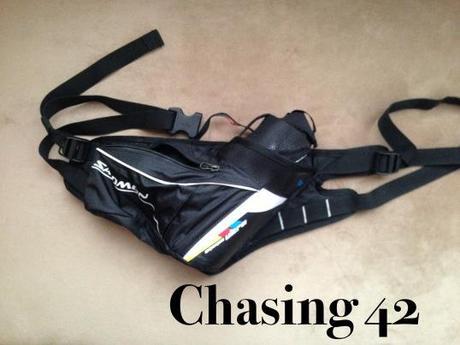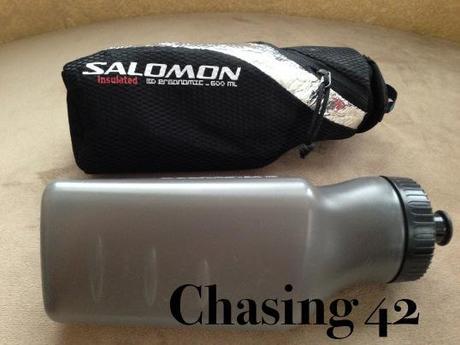It is perhaps perfect timing for me to be thinking about hydration and longing for the hot summer months as a winter storm bears down on the entire state of Iowa. As I’ve discussed before, thinking about hydration comes pretty naturally during the summer months when you feel like you can’t possibly drink enough water to keep up with the sweating, and you wish it was socially acceptable to run naked just so your core temperature was a bit lower. Ok, perhaps running naked would present its own challenges, but you know what I mean. However, when winter sets in, the temperature drops, the snow falls to the ground, and the wind cuts through me like a knife (at least in Iowa, where there is nothing to break it!), the last thing I’m thinking about consistently is hydration. I guess I’m just much less likely to feel thirsty when the snot is freezing to my face  However, at the point where I’m not feeling the need to hydrate, I need it even more!
However, at the point where I’m not feeling the need to hydrate, I need it even more!

But how do I drink the water in the first place?
There are a number of considerations to keep in mind during the winter months with regard to hydration:
1. You still sweat- This is probably the hardest fact for me to remember at times! When I’m out in the cold, my core temperature warms up eventually, and even my fingers and toes find some heat after about 6 miles, but I never have the reminder of sweat dripping down my face. It’s not until I step inside out of the cold that I realize my base layers are soaked pretty thoroughly.
2. Lower humidity The cold hair is typically much drier, unless it happens to be precipitating. This means you are at an even greater risk of dehydration.
3. Access to Water- During the summer months, I can head out for most of my runs around town and not even bother bringing a water bottle. Our community has a wonderful park system, and water fountains are everywhere. However, these fountains are obviously turned off during the winter months so the pipes don’t freeze. I still have the option of stopping at gas stations and other retail locations, but my overall access to water is much more limited. Carrying it becomes that much more important!
4. Water freezes- I know you are shocked by this revelation in science. When the cold sets in, the ability to drop water along the route or even carry it with you becomes compromised. Carrying water doesn’t do you much good if you end up with a block of ice in your hand after 45 minutes! Now, adding sugar (as in most nutrition beverages such as Gatorade or Powerade) does lower the freezing point of the liquid, but I try to stay away from sugary energy drinks, especially if there is some sugar in my solid nutrition.
5. Your blood thickens- As the temperature drops, blood viscosity increases. This means your heart is working harder to pump blood to your limbs, and you risk not getting enough oxygen to your extremities. This makes hydration, and the use of electrolytes that much more important!
I’m certainly much more likely to stay hydrated if I remember to bring water with me, as opposed to designing a limited route that stops at the various locations where I still have access to water. This year, I’ve been using the Salomon pack below for most of my long runs. The bottle is insulated, which means my water never freezes, and there is plenty of storage room for all of the nutrition I need, no matter the distance. You can find plenty of insulated water bottles online as well, and incorporate them into the gear you already own/use.


If you are looking for some more information on winter running, you can check out these resources below, courtesy of HowStuffWorks:
Sources
- McManus, Melanie Radzicki. “Winter Advisory.” Runner’s World. August 2004. (Sept. 5, 2010) http://www.runnersworld.com/article/0,7120,s6-238-267-269-9262-0,00.html
- Morris, Rick. “Dressing For Cold Weather Running – Staying Warm And Dry When Running In Cold Weather.” Running Planet. 2010. (Sept. 5, 2010) http://www.runningplanet.com/training/dressing-for-cold-weather-running.html
- Morris, Rick. “Running In Cold Weather – How To Avoid Hypothermia and Frostbite.” Running Planet. 2010. (Sept. 5, 2010) http://www.runningplanet.com/training/running-in-cold-weather.html
- “North Pole Marathon: World’s Coolest Marathon.” North Pole Marathon. 2010. (Sept. 5, 2010) http://www.npmarathon.com/
- Pribut, Stephen M. “Running in the Cold.” Dr. Pribut’s Running Injuries Page. Jan. 23, 2010. (Sept. 5, 2010) http://www.drpribut.com/sports/spcold.html
- “Since I don’t sweat much when it’s cold, do I still need to hydrate during my runs?” Runner’s World. Dec. 5, 2006. (Sept. 5, 2010) http://www.runnersworld.com/article/0,7120,s6-238-267–11144-0,00.html
- Solkin, Mindy. “Running in the Cold.” MarathonGuide.com. 2010. (Sept. 5, 2010) http://www.marathonguide.com/training/coachmindy/runninginthecold.cfm
- Switzer, Kathrine. “Don’t Let the Cold Slow You Down: Tips For Cold Weather Workouts.” Cool Running. 2010. (Sept. 5, 2010) http://www.coolrunning.com/engine/2/2_1/dont-let-the-cold-slow-yo.shtml
